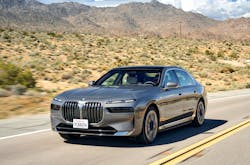PG&E, BMW Begin Vehicle-to-Grid Energy Storage Testing
As electric vehicles (EVs) become more prevalent, with nearly 40% of all EVs in the United States driving on California roads, Pacific Gas and Electric Co. and BMW of North America are collaborating to test how vehicle-to-grid energy storage technology can serve as a solution to offset growing demand on the power grid, improve reliability for electric customers, and maximize the usage of renewable energy.
The partners say this energy storage use case, which they refer to as “vehicle to everything” or V2X, could enable customers to use their vehicles as backup home generation when needed.
The V2X testing is taking place at PG&E’s Applied Technology Services (ATS) Lab in San Ramon and is the focal point of an extended partnership to advance V2X technology and explore using of EVs as a flexible grid resource. The collaborative testing builds on the momentum of the ChargeForward smart charging program, which was announced in 2015 and offers PG&E customers who drive a BMW EV, incentives to align vehicle charging with renewable energy to help support the overall sustainability of the electric grid.
V2X technology will someday empower EV drivers to return excess stored energy from their vehicle batteries back to the grid in exchange for compensation, presenting an ideal response to high-demand power conditions and a key solution for grid stability and resiliency. Additionally, V2X technology could play an important role in increasing the amount of greenhouse gas (GHG)-free resources powering the grid by storing solar and wind energy generated during the day to supplement the availability of clean energy during the peak evening demand period and overnight.
The pilot is assessing how a typical home could maximize its renewable energy usage by switching between EV battery stored renewable energy and grid-provided renewable energy. The EV battery charges when the renewable energy mix on the grid is highest and the battery discharges throughout the day to support the household load. Results show that a vehicle-to-home connected EV is capable of providing roughly double the amount of renewable energy that a typical California household would be able to use on an average day, increasing customers’ ability to use more green energy on a daily basis. Testing also offers insights on how V2X vehicles perform under real-world scenarios, taking into consideration vehicle functionality and driver behavior to ensure that EVs can be used as a viable grid resource while still meeting customer needs.
PG&E and BMW will continue collaborating to better understand how these learnings can be applied to consider other customer and utility benefits.
This expanded partnership, focused on V2X testing, is a result of the success of the ChargeForward program. Conceived eight years ago, and now in its third pilot phase, BMW and PG&E were the first to offer customers cash incentives for maximizing renewable energy by optimizing their EV charging times to support the overall reliability of the electric grid. It is available to all BMW battery and plug-in EV drivers in Northern and Central California who are also PG&E residential electric customers.
This last year showed that by aligning charging with renewable energy, BMW drivers helped the grid generate and support more clean energy. In California 1.4 million miles were powered by 100% renewable energy in 2022.
BMW and PG&E will extend their partnership until March 2026 with a focus on smart charging testing. In the next stage of this collaboration, BMW and PG&E will work together to continue testing V2X-enabled vehicles, specifically vehicle-to-grid (V2G), in a field trial at BMW Group Technology Office USA located in Mountain View, Calif. BMW will develop a test fleet of V2X vehicles that will be used in day-to-day operations and serve as a grid resource to help integrate renewable energy and balance the grid. This field test will evaluate how V2X technology can be used for advanced use cases that can be commercialized in future years and help support renewable integration on a neighborhood level to increase grid reliability on a larger scale.
About the Author
T&D World Staff
Content Team
Nikki Chandler
Group Editorial Director, Energy
[email protected]
Jeff Postelwait
Managing Editor
[email protected]
Christina Marsh
Senior Editor
[email protected]
Ryan Baker
Associate Editor
[email protected]
Amy Fischbach
Electric Utility Operations
[email protected]
Rich Maxwell
Community Editor
[email protected]
Gene Wolf
Technical Editor
[email protected]
